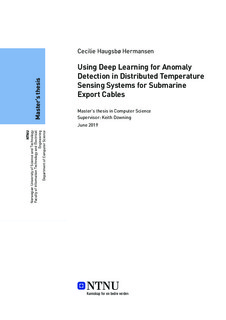| dc.contributor.advisor | Downing, Keith | |
| dc.contributor.author | Cecilie Haugsbø Hermansen | |
| dc.date.accessioned | 2019-11-09T15:00:11Z | |
| dc.date.available | 2019-11-09T15:00:11Z | |
| dc.date.issued | 2019 | |
| dc.identifier.uri | http://hdl.handle.net/11250/2627506 | |
| dc.description.abstract | Eksportkabler er viktige komponenter i en offshorevindmøllepark, siden de trans- portere den produserte energien til land. Feil i kablene kan føre til store tap for operatørene, og de vil derfor overvåke kablene for å kunne varsle om feil under utvikling som kan korrigeres. Fysiske lover regulerer forholdet mellom tempera- turene i eksportkablene, strømmen gjennom kabelen og omgivelsene. Det er komplisert å fysisk modellere disse forholdene, men de kan læres implisitt av en dyp læring-modell.
Asynkrone datakildene beskriver systemet rundt eksportkabelen. Eksperimenter ble utført for å fastslå hvordan asynkronisiteten best skulle håndteres i dyp læring-modeller. Den foretrukne modellen var en LSTM modell med inputdata resamplet til å være synkron, men ujevnt samplet.
Det er ikke kjent at det har vært feil i kabelen. Den normale oppførselen til temperaturene i kabelen ble modellert, og avvik ble brukt til å finne feil. Syntetiske feil ble konstruert for å evaluere de forskjellige modellene. Feildeteksjon basert på temporale og spatiale forhold ble undersøkt hver for seg. De beste modellen ble kombinert, men slo ikke den beste spatiale modellen. Den beste modellen bruke prinsipalkomponentanalyse (principal component analysis, PCA) til å encode og rekonstruere sekvenser av kabeltemperaturer, og fikk gode resultater på de konstruerte feilene.
Til slutt er en ny metode for trening og validering av modeller for periodisk tidsseriedata foreslått. Den er basert på kryssvalidering, og går ut på å dele dataene opp i små, sammenhengende blokker som tilfeldig fordeles på det ønskede antallet deler. | |
| dc.description.abstract | Export cables are essential components in offshore wind farms, as they are responsible for transporting the produced power to the shore.
Any failures in the export cables can lead to huge losses for the operators, and thus they want to monitor the cables to be alerted of any developing faults that can be corrected. Physical laws govern the relationships of the temperatures of the cable, the electric current through the cable and the surrounding environment. These relationships are complicated to model physically, but might be implicitly learned by a machine learning model.
Asynchronous data sources describe the system of the export cable and its surroundings.
Experiments were conducted to establish how best to handle this asynchronicity in deep learning prediction models.
The preferred model was an LSTM with inputs resampled to the same uneven sampling rate.
No known failures have occurred in the export cables. The normal behaviour of the temperatures of the cable was modelled, and deviating behaviour was used to detect anomalies. Synthetic faults were constructed to evaluate the anomaly detection models.
Anomaly detection based on temporal and spatial relationships was explored separately. The best models were combined, but the combined model did not beat the best spatial model.
The best model used principal component analysis to encode and reconstruct sequences of temperatures through the cable, and got impressive results for the constructed gradually developing faults.
Additionally, a new cross validation based evaluation scheme for time series data with seasonality is proposed. It involves dividing the data into small consecutive blocks, and randomly dividing the blocks into the required number of folds. | |
| dc.language | eng | |
| dc.publisher | NTNU | |
| dc.title | Using Deep Learning for Anomaly Detection in Distributed Temperature Sensing Systems for Submarine Export Cables | |
| dc.type | Master thesis | |
